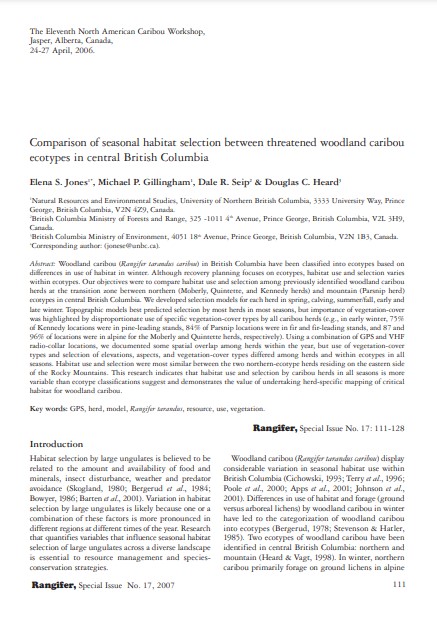Comparison of seasonal habitat selection between threatened woodland caribou ecotypes in central British Columbia
Bosque Modelo:
McGregor
Temática:
Gestión forestal
Tipo de documento:
Artículo científico
Resumen
Woodland caribou (Rangifer tarandus caribou) in British Columbia have been classified into ecotypes based on
differences in use of habitat in winter. Although recovery planning focuses on ecotypes, habitat use and selection varies within ecotypes. Our objectives were to compare habitat use and selection among previously identified woodland caribou herds at the transition zone between northern (Moberly, Quintette, and Kennedy herds) and mountain (Parsnip herd) ecotypes in central British Columbia. We developed selection models for each herd in spring, calving, summer/fall, early and late winter. Topographic models best predicted selection by most herds in most seasons, but importance of vegetation-cover was highlighted by disproportionate use of specific vegetation-cover types by all caribou herds (e.g., in early winter, 75% of Kennedy locations were in pine-leading stands, 84% of Parsnip locations were in fir and fir-leading stands, and 87 and 96% of locations were in alpine for the Moberly and Quintette herds, respectively). Using a combination of GPS and VHF radio-collar locations, we documented some spatial overlap among herds within the year, but use of vegetation-cover types and selection of elevations, aspects, and vegetation-cover types differed among herds and within ecotypes in all seasons. Habitat use and selection were most similar between the two northern-ecotype herds residing on the eastern side of the Rocky Mountains. This research indicates that habitat use and selection by caribou herds in all seasons is more variable than ecotype classifications suggest and demonstrates the value of undertaking herd-specific mapping of critical habitat for woodland caribou.
Información Bibliográfica
Autor:
Jones, ES, MP Gillingham, DR Seip and DC Heard.
Revista:
Rangifer
Año:
2007
N°:
-
País :
Canadá
Páginas:
111 - 128
Volumen:
17
Idioma:
Ingles
Palabras claves
GPS, herd, model, Rangifer tarandus, resource, use, vegetation.





